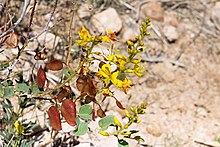
Bauhinia is a large genus of flowering plants in the subfamily Cercidoideae and tribe Bauhinieae, in the large flowering plant family Fabaceae, with a pantropical distribution. The genus was named after the Bauhin brothers Gaspard and Johann, Swiss-French botanists.

Chamaecytisus is a genus of flowering plants in the legume family, Fabaceae. It belongs to the subfamily Faboideae. It may be a synonym of Cytisus. C. palmensis is a tree from the Canary Islands used as a fodder crop around the world.

Cyamopsis is a genus of the family Fabaceae. Its species are distributed across Africa, Asia and the Pacific.

The genus Tylosema is in the plant family Fabaceae and encompasses four accepted species of perennial legume native to southern and central Africa. These are semi-woody viniferous plants broadly distributed from Sudan and Ethiopia south to Angola and South Africa. Coetzer and Ross originally described four Tylosema species:

Baphia is a small genus of legumes that bear simple leaves. Baphia is from the Greek word βάπτω, referring to a red dye that is extracted from the heartwood of tropical species. The genus is restricted to the African tropics. Baphia was traditionally assigned to the tribe Sophoreae; however, recent molecular phylogenetic analyses reassigned Baphia to the tribe Baphieae.

Gigasiphon is a genus of legume in the family Fabaceae. The genus is circumscribed is defined by "a long-tubular hypanthium, an arborescent habit, and a calyx divided into two lobes."

Barklya is a genus of Australian trees in the legume family, Fabaceae. It belongs to the subfamily Cercidoideae. The sole species is Barklya syringifolia, commonly known as the leather jacket or crown of gold tree. It grows in rainforest to 18 metres tall. Recorded from Queensland and New South Wales in vine forest and softwood scrub. It is often used as an ornamental. It may be extinct in New South Wales.
Baudouinia is a genus of flowering plants in the legume family, Fabaceae. It belongs to the subfamily Dialioideae.
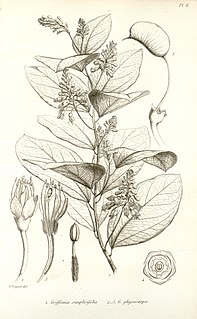
Griffonia is a genus of flowering plants in the legume family, Fabaceae. It belongs to the subfamily Cercidoideae. Griffonia is known to have a high concentration of 5-HTP in its seeds.
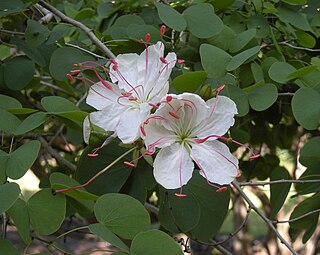
Lysiphyllum is a genus of flowering plants in the legume family, subfamily Cercidoideae and tribe Bauhinieae. It belongs to the subfamily Cercidoideae. It was formerly treated as part of the genus Bauhinia, but recent molecular phylogenetic analysis confirms that Lysiphyllum is a distinct genus from Bauhinia.
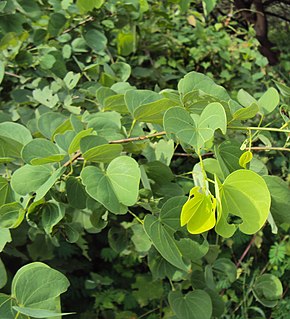
Piliostigma is a genus of flowering plants in the legume family, Fabaceae. It belongs to the subfamily Cercidoideae and the tribe Bauhinieae.
Baphiopsis parviflora is an African species of flowering plants in the legume family, Fabaceae. It belongs to the subfamily Faboideae. It is the only member of the genus Baphiopsis. It was traditionally assigned to the tribe Swartzieae; however, recent molecular phylogenetic analyses reassigned Baphiopsis parviflora into the Baphieae tribe.
Disynstemon paullinioides is a species of flowering plants in the legume family, Fabaceae. It belongs to the subfamily Faboideae. It is a liana that is native to Madagascar. It is the only member of the genus Disynstemon.
Leucomphalos is a genus of flowering plants in the legume family, found in west Africa. It belongs to the subfamily Faboideae. Leucomphalos was traditionally assigned to the tribe Sophoreae; however, recent molecular phylogenetic analyses reassigned Leucomphalos to the Baphieae tribe.
Rhynchotropis is a genus of flowering plants in the legume family, Fabaceae. It belongs to the tribe Indigofereae of the subfamily Faboideae.
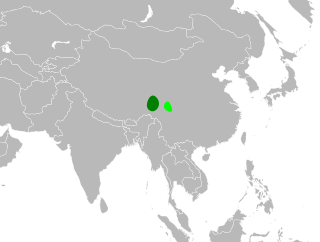
Salweenia is a genus of flowering plants in the legume family, Fabaceae. It belongs to the subfamily Faboideae.
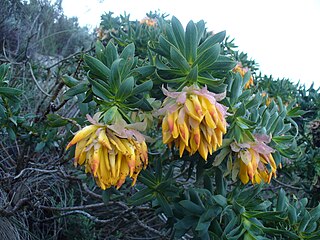
Liparia is a genus of flowering plants in the legume family, Fabaceae. It belongs to the subfamily Faboideae.
Lasiobema is a genus of flowering plants in the legume family, Fabaceae, most of which are lianas. It belongs to the subfamily Cercidoideae and the tribe Bauhinieae. It was recently synonymized with Phanera on the basis of morphology, but this move has been questioned.

Schnella is a genus of flowering plants in the legume family, Fabaceae. It belongs to the subfamily Cercidoideae. All of its species are neotropical lianas.
Indigastrum is a genus in the tribe Indigofereae of the family Fabaceae.
